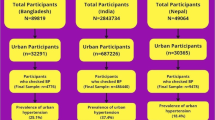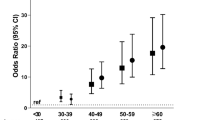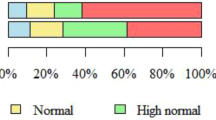Abstract
Background: Many black persons in South Africa have been subjected to urbanisation and urbanisation has led to a significant increase in diseases of lifestyle. The determinants of hypertension in a population in transition have not been well-defined and there is a pressing need for observational epidemiological studies as well as randomised-controlled trials in populations from Africa. The aim of this study was to investigate the association between blood pressure and factors known to contribute to hypertension.
Methods: The study sample consisted mainly of Setswana speaking people, divided into different levels (strata) of urbanisation, namely stratum 1 (rural) to stratum 5 (urbanised). A total of 1821 black subjects, which included 1040 woman, were recruited and randomly selected from 37 sites from the four geographical quarters of the North West Province of South Africa. The following questionnaires were used: demographic, anthropometric, quantitative food frequency, physical activity and scales to measure psychosocial variables. Biochemical analysis (standardised methods) were done on the serum and plasma of the subjects and the blood pressure was measured with a sphygmo- manometer.
Results: Of the total sample, 22.8% of the subjects had systolic and 20.7% diastolic blood pressures above 140/90 mm Hg. Males and females from stratum 3 showed the highest rate of hypertension (32.9% systolic and 25.1% diastolic) and stratum 5 the lowest. Blood pressure correlated positively with age, level of urbanisation, WHR (waist:hip ratio) and smoking. In the woman the diastolic blood pressure correlated the best with body mass index (BMI), serum triglycerides, total serum cholesterol, low-density lipoprotein (LDL) cholesterol and s-GGT. Coping strategies, experience of social support, cultural aspects and affect balance are related to blood pressure, especially in the case of women.
Conclusions: It seems that factors associated with urbanisation are related to the manifestation of hypertension in black people of the North West Province, given the highest mean blood pressure in people living in informal settlements, where most newcomers to the urban areas live.
This is a preview of subscription content, access via your institution
Access options
Subscribe to this journal
Receive 12 digital issues and online access to articles
$119.00 per year
only $9.92 per issue
Buy this article
- Purchase on Springer Link
- Instant access to full article PDF
Prices may be subject to local taxes which are calculated during checkout
Similar content being viewed by others
Author information
Authors and Affiliations
Corresponding author
Rights and permissions
About this article
Cite this article
van Rooyen, J., Kruger, H., Huisman, H. et al. An epidemiological study of hypertension and its determinants in a population in transition: the THUSA study. J Hum Hypertens 14, 779–787 (2000). https://doi.org/10.1038/sj.jhh.1001098
Received:
Revised:
Accepted:
Published:
Issue Date:
DOI: https://doi.org/10.1038/sj.jhh.1001098
Keywords
This article is cited by
-
Individual and area-level socioeconomic correlates of hypertension prevalence, awareness, treatment, and control in uMgungundlovu, KwaZulu-Natal, South Africa
BMC Public Health (2023)
-
Cardiovascular function is not associated with creatine kinase activity in a black African population: The SABPA study
BMC Cardiovascular Disorders (2016)
-
Nitric oxide synthesis capacity, ambulatory blood pressure and end organ damage in a black and white population: the SABPA study
Amino Acids (2016)
-
Analysing the socioeconomic determinants of hypertension in South Africa: a structural equation modelling approach
BMC Public Health (2014)
-
Attenuated NOx responses and myocardial ischemia, a possible risk for structural vascular disease in African men: the SABPA study
Journal of Human Hypertension (2014)



